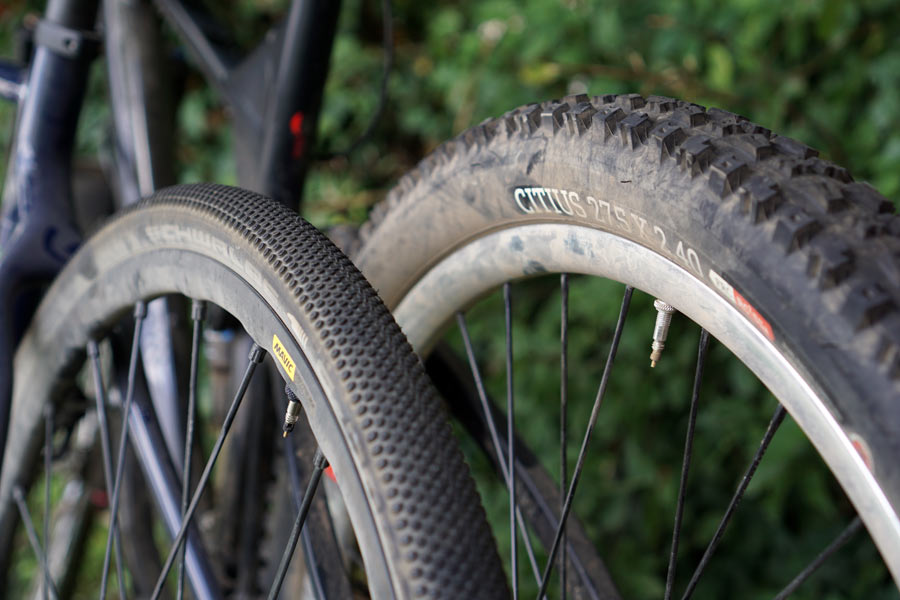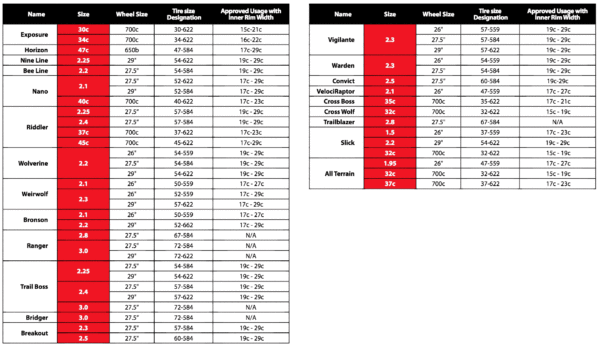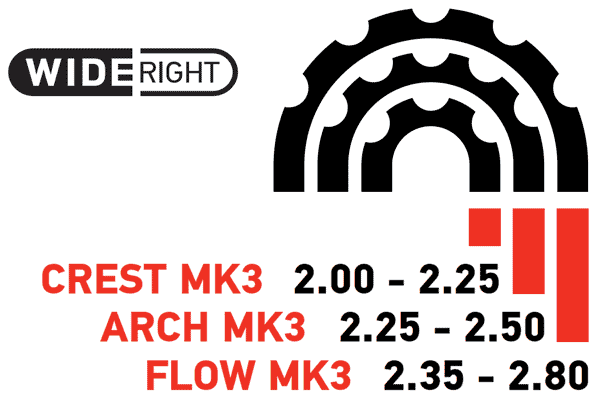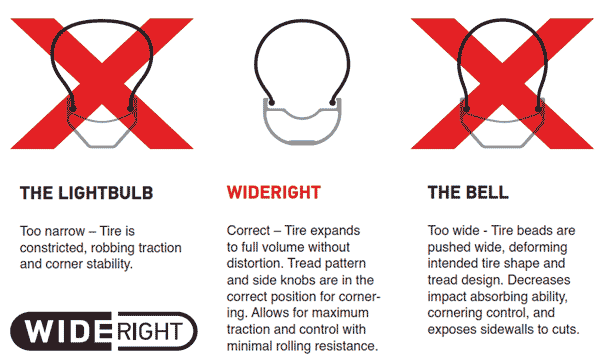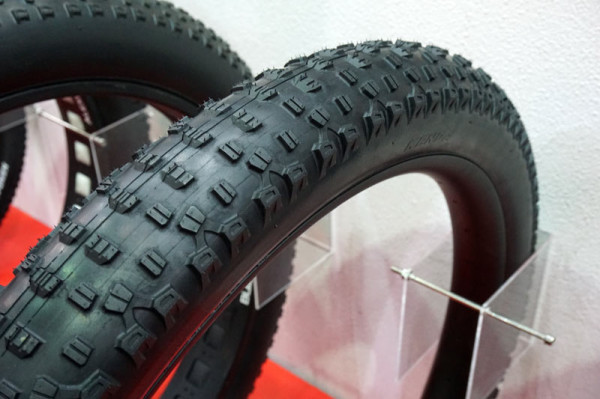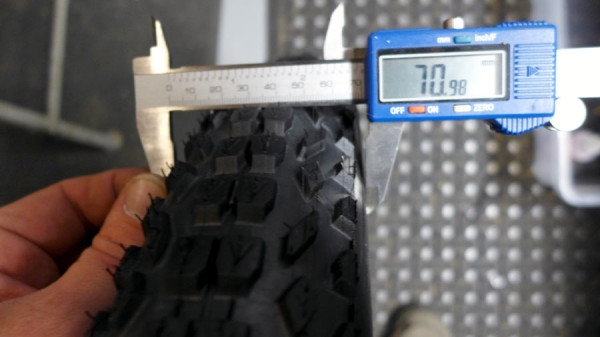With the explosion of Boost, Plus bikes, Mid Fat and other portly new rim and tire sizes for everything from road to cyclocross to gravel to mountain bikes, it’s a wonder there isn’t more confusion as to what will actually work together.
And by “work together”, we don’t just mean whether or not it’ll mount. We wanted to know what the compatibility limitations are for optimum performance and, more importantly, safety. If we’ve learned one thing from Mavic’s presentations over the years, it’s that tire and rim sizes really and truly are designed to work in tandem. Step outside the guidelines and you risk poor performance, component damage, or even a total blowout. And it’s not just Mavic. We spoke with WTB, Kenda, Schwalbe, Stan’s NoTubes and Industry Nine to see where everyone sits on the matter. Here’s what they had to say…
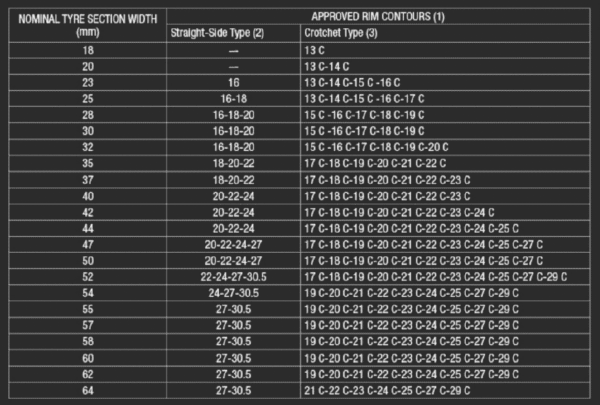
First off, we should mention that it’s not only the brands listed here that are concerned about such things. Many more are part of the global conversation, most of which contribute to and follow design standards set by ISO for the ETRTO standards. According to Mavic, the ISO organization is currently updating standards to deal with the latest trends hitting the market, including:
- Road Tubeless rims/tires dimensions
- MTB tubeless with crochet/hooked rims
- MTB hookless rims/tires dimensions
- MTB tubeless hookless rims/tires dimensions
- wider rims (up to 50 c) with bigger volume tires (up to 4 inches)
Looking at the chart above, it’s no wonder Mavic’s rim width growth has been moderate compared to the rest of the industry. They’d rather sell you a proper rim/tire system that’s designed to work flawlessly and safely then pump out a 40mm wide rim just because you think you want it. And maybe you do. And maybe that’s OK.
The official updates will be good, because WTB told us there are no current ETRTO tire size recommendations for internal rim widths greater than 29mm. That’s why you’ll find “N/A” next to some of their bigger tires on the charts above. They do have internal recommendations, though, so don’t be afraid to ask.
About those tire size designations – those are the ETRTO measurements, which are the global standard. The smaller number on the front refers to the tire’s width in millimeters. The larger number refers to the rim diameter they’re made for:
- 622mm = 700c road and 29er MTB
- 584mm = 650B/27.5″ mountain bike
- 559mm = 26″ mountain bike
Side note: The 700, 650, 26″, 27.5″ & 29″ wheel size numbers that we so commonly use actually refer to an approximate average outside tire diameter, not the real size of the rim. Confused yet?
HOW BRANDS CAN HELP YOU PICK THE RIGHT COMBO
While some brands follow strict charts, others provide a bit looser guidelines. Industry Nine have suggested tire width ranges for many of their rims and had this to say on how and why they come up with those figures:
“It is primarily based on experience, testing, and feedback from our customers as well as the professional athletes we work with. The basics are that if you run a rim that is too wide for a particular tire you have a lot more issues with tire and rim damage, as the rim is much more likely to bottom out on lateral rock impacts causing tire or rim damage.
“Conversely, if the tire is too wide for a given rim, you get more tire roll due to the larger casing size and higher aspect ratio of the tire, which together create more leverage on the tire allowing the casing to collapse and roll over the rim during hard cornering. Our suggestions are based on what we feel is the best balancing act between all of these elements. However, some tires have more or less tread wrap which certainly affects this. A 2.25″ tire with a lot of tread wrap might function reasonably well on a 35mm (internal width) rim, but it is our opinion that the customer would still be better served on a narrower rim for the above reasons. In addition, wider rims are always going to weigh more – all things being equal. Customers who are generally considering narrower 2.1-2.25” tires are typically going to be more weight conscious, so they are going to be better served by a narrower/lighter rim in many cases.
All of this being said, there is certainly a large element of personal preference that comes into play as well, and the guidelines we offer are suggestions, not hard/fast rules. Of course, once you get to the extremes safety becomes a factor as well. You obviously wouldn’t want to run a 2.2″ tire on a fatbike rim or a plus tire on one of our Ultralite rims.”
Taking the graphical approach a step further, Stan’s NoTubes is readying new imagery for their website that list recommended tire width ranges for specific rims.
Their “Wide Right” concept helps us visualize what an appropriate tire shape should look like. Of course, this doesn’t do much good if you’ve already purchased the rims and tires only to find things are pear shaped, which is why the numbers are also handy. Something else to noodle on – Schwalbe says many tires are intentionally manufactured on the narrow side of the allowed tolerances because they’ll likely stretch a few millimeters during your first several rides.
So far, we’ve talked a lot about fitting a wider tire on your existing rims. But what if you’re only upsizing your rim, hoping to gain a little extra width from your existing tire? Kenda has some guidelines on that, which they say work regardless of which wheel size (26, 27.5, 29, etc.) you ride:
“The general rule of thumb on the effect of rim width to tire width is for every 1mm, plus or minus, of difference from the design standard (i.e. ideal rim width for a given tire) the tire will change about 0.4mm in width in the same corresponding direction.
“For example, if a 2.20 tire (56mm) was designed to be used on a rim with an internal measurement of 24mm and you were to mount it on an extra wide rim with an internal measurement of 29mm, it would pull the overall width of the tire closer to 58mm, making the tire closer to a 2.30.
“There are upsides to making a tire wider this way, no added weight, no waiting for a tire manufacturer to make your favorite tire in a slightly larger size . . . but this comes at the expense of changing how that tire contacts the ground. This could mean an increase in rolling resistance or it could change the relative location of the cornering knobs resulting in a tire breaking loose earlier in a corner.”
Simple translation: Put a wider rim on your bike and your tire will grow about 0.4mm wider for every 1mm of internal rim growth.
SO, WHAT REALLY GOES WITH WHAT?
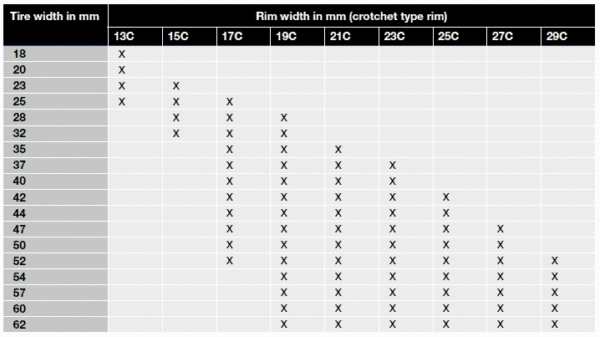
For reference, a 62mm wide tire is 2.44″, which is where the current standards formally end. But, with some calculations of the ETRTO standards, we came up with a rough guideline suggesting your rim width should be between 32% to 70% of the tire width. For a 2.8″ tire, that means rims with an internal width of 23mm to 49mm. Based on all of these conversations behind this story, our hunch is that the “ideal standard” lies near the upper middle of that range, so something like a 35-40mm IW rim would be the best starting point for safety, optimized performance and a good tire profile. Disclaimer: That’s our math and opinion based on the charts and excludes the narrowest tire width fringes, so use at your own risk.
WHAT ABOUT FAT BIKES?
Using our formula, a 4.0″ (101mm) fat bike tire would need an internal rim width between 34mm and 71mm. That puts it at the starting point for many fat bike rims. The Hed Big Deal alloy comes in at 71mm inside, and the Sun-Ringle MuleFut measures 74.4 (for their largest 80 rim; they also offer a narrower 50). So then, how do you pair fat bike rims and tires? Are standards simply thrown out the window for these? Well, there are no guidelines, and it depends on how you want your tire profile.
We spoke with Tim Krueger, who’s one of the guys behind the new Terrene Tire brand and himself a fat bike enthusiast. He says there simply are no current standards. He also says that while the same concerns about tire roll with too-narrow rims or smashing rims with too-narrow tires apply to fat bikes, their massive tire volume somewhat mitigates those issues. It comes down to riding style and preference. Want a more squared off tire shape for floating on snow? Go with wider rims. Need a proper round profile for dry singletrack? Go a little narrower.
Industry Nine says their general rule of thumb puts a 90mm IW rim with 4.8 to 5.0 inch tires for snow. For more standard 3.8 to 4.0 inch tires, they’re pairing 75-80mm widths if you’re riding on snow. But go as narrow as a 50mm wide rim with higher pressures for summer riding. To them, that was the extreme, and probably not the best combo for most people, but they’ve seen it done.
THE TAKEAWAY
Whether your riding road, gravel, cyclocross, trail or enduro, a good starting point is likely using a rim with an inside width of 50-65% of your tire width. Finding a good bike shop that’ll let you mount several rim and tire combos helps you know before you go, but don’t hesitate to contact the brands for their input, too.
